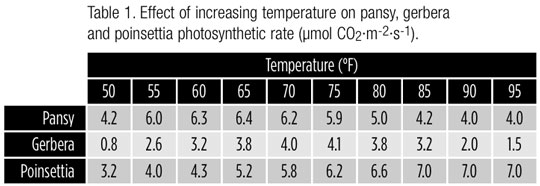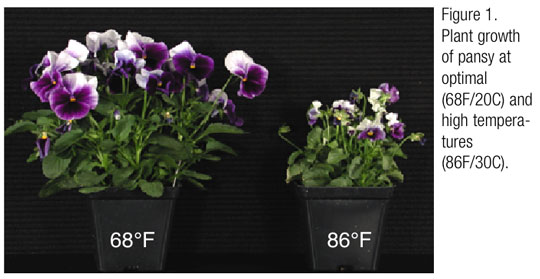3/26/2013
Are Hot Temps Hurting Your Crops?
John Erwin, Esther Gesick and Jennifer Boldt
Temperature and light affect both how much and how fast a plant can increase in size. Light drives photosynthesis, which is what makes plants increase in size or mass. In general, increased photosynthesis leads to larger plants, more or earlier flowering and a longer postharvest life. Temperature drives all chemical reactions, including photosynthesis, and determines how fast a plant develops.
Plant development rate is often measured by leaf unfolding rate. Both photosynthesis and leaf unfolding increase as temperature increases up to some optimal temperature. Once temperatures exceed the optimal temperature, leaf unfolding and photosynthesis slow. In Figure 1, you can see how, compared to an optimal temperature of 68F (20C), high temperature (86F/30C) reduced photosynthesis on the pansy, which resulted in reduced plant size. We suspect we routinely reduce photosynthesis and leaf unfolding by letting greenhouses get too hot. This article shows how high temperatures can decrease photosynthesis and leaf unfolding in some common crops we grow.
How does temperature affect photosynthesis in different crops?
Species differ in their optimal temperature for photosynthesis. For instance, Figure 2 shows the effect of temperature on photosynthesis of pansy (a), gerbera (b) and poinsettia (c). You can see that pansy had a relatively low optimum for photosynthesis of around 65 to 68F (18 to 20C). Gerbera had an optimum at approximately 75 to 78F (23 to 25C) and poinsettia had an optimum at around 84 to 87F (28 to 30C). Note that with pansy and gerbera, in particular, photosynthesis decreased when temperatures increased above the optimal temperature.
How does temperature affect leaf unfolding of different crops?
Unlike photosynthesis, where responses to temperature are variable across species, temperature effects on leaf unfolding rate are similar across species. For instance, leaf unfolding of many crops increases as temperature increases from 50F (10C) to 80 to 86F (26 to 30C) (Figure 3). As temperature increases above 86F (30C), leaf unfolding decreases in many crops and plants will develop more slowly.
What is the effect of allowing plant temperatures to increase over 85F (29C)?
In general, temperatures above 86F (30C) decreased leaf unfolding in most crops we studied (Figure 3). The greater temperatures are above 86F, the slower they developed/grew. If we look at the generic leaf unfolding curve developed from data on African violets, we see that if temperature increases from 86 to 96F (35C), leaf unfolding rate decreased by about one-third. In other words, it will take one-third longer to grow the crop when grown at a constant 96F versus a constant 86F.
In contrast to leaf unfolding, as mentioned above, how high temperatures affects photosynthesis differed with species (Figure 2). Table 1 shows the effects of increasing temperature on photosynthetic rates of some crops we researched. Note that increasing the day temperature from 70F (21C) to 90F (32C) decreased photosynthesis from 5.9 to 4.0 µmol CO2·m-2·s-1 on pansy (- 32%), decreased photosynthetic rate from 4.1 to 2.0 µmol CO2·m-2·s-1 on gerbera (- 51%), but increased photosynthetic rate from 6.2 to 7.0 µmol CO2·m-2·s-1 on poinsettia (+ 13%). This is one reason we can successfully grow poinsettia plants in greenhouses in August across much of the country, but can only successfully grow pansies in August in cooler parts of the country. (Table 1)

These data show that cooling systems are more beneficial for growing some crops than with others. For instance, a cooling system, good top and side vents, and/or fans are more important when growing pansies and gerbera than when growing poinsettias. These data also show that when we let temperatures get too high in a greenhouse in spring to save on night heating costs, we can actually decrease plant size and quality of some species (as seen in Figure 1).

Plant temperature is not necessarily the same as air temperature!
Plant temperatures may be different than what we think. For instance on a sunny day, plant temperatures are usually warmer than the surrounding air temperature. How much warmer will depend on light intensity and air humidity. In general, plant temperature is typically 5 to 10F (3 to 6C) warmer on a sunny day in a greenhouse than air temperature. In contrast, on a cloudy day, plant temperatures can often be similar to the air temperature. Lastly, on a clear night, plants temperatures can actually be less than the air temperature.
When considering photosynthetic rates and leaf unfolding as above, greenhouse air temperatures should be adjusted to get the desired plant temperature. Not doing this may 1) cause plant scheduling to be inaccurate; 2) result in negative effects on plant photosynthesis and development rate if plant temperatures are too warm; and 3) cost you more money in some cases if growth rate is slowed and plant quality is reduced by excessive temperatures.
Let’s look at one example: If your air temperature in a greenhouse where you’re growing a gerbera crop is 85F (29C) on a sunny day, your actual plant temperature in a humid greenhouse could be 95F (35C). If this is the case, we can see from Table 1 that your gerbera photosynthetic rate would decrease from 3.2 to 1.5 µmol CO2·m-2·s-1—a nearly 50% drop! Similarly, leaf unfolding would be slowed. Therefore, on a sunny day, air temperatures will need to be lowered to around 75F (23C) to achieve the desired plant temperature of no more than 85F (29C)—remember that Figure 3 shows a 76 to 78F (24 to 25C) plant temperature was optimal for gerbera.
The bottom line
We believe that crops routinely get too warm in greenhouses in the spring. The result of this is that plant quality is reduced and crop development is slowed. What are some things you can do now to make sure this doesn’t happen in your facility?
1| Buy an infrared thermometer and measure your plant temperatures. Adjust your computer or controller settings to reduce air temperatures on sunny days to achieve the desired plant temperature.
2| Move the light meters, temperature sensors, etc. that control shading, heating, fans or cooling systems into the greenhouse and place them at plant level in order to accurately adjust set points based on whether it’s cloudy or sunny.
3| Reconsider allowing plant temperatures to exceed 85F (29C) at any time. Photosynthesis is often decreased and leaf unfolding is often slowed at temperatures above this.
4| You may want to have different cooling systems for different crops, depending on the crop. Place some crops in your best-cooled greenhouses and other crops in greenhouses with poor cooling. In general, plants can be divided into cool temperature preferring (65 to 68F/18 to 20C—pansy), intermediate temperature preferring (74 to 78F/23 to 25C—gerbera), and warm temperature preferring (82 to 85F/27 to 29C—poinsettia) with respect to photosynthesis.
5| Remember that the data on temperature and photosynthesis only applies to day temperatures.
6| Know the optimal temperatures for photosynthesis of the crops you grow!
GT
John Erwin is Professor of Greenhouse Crop and Floriculture Physiology and Extension, Esther Gesick is a Research Fellow, and Jennifer Boldt is Graduate Research Assistant for the Department of Horticultural Science at the University of Minnesota in St. Paul, Minnesota.